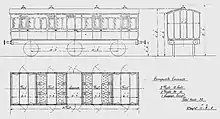

John Alexander Dickman (17 May 1864 – 10 August 1910) was an Englishman hanged for murder.
Description
Dickman was convicted of the murder of John Innes Nisbet, which took place on a train travelling between Newcastle railway station and Alnmouth railway station, on 18 March 1910. Nisbet had been carrying a bag containing the wages for a colliery. His body was discovered in a train compartment in a full-width compartment carriage (with no aisle and no corridor); he had died of five gunshot wounds to the head and his bag had been stolen along with £370 of colliery wages that were never recovered (the near empty bag was later found in a local mineshaft with only a few coins inside). Dickman’s clothing was examined and appeared to be stained with blood, and his Burberry overcoat showed signs of being recently scrubbed with paraffin, a substance used at the time for removal of bloodstains. Police also later found evidence that Dickman had received a pistol from a gunsmith in October 1909.[1]
On 6 July Dickman was convicted by a jury of the murder of Nisbet and he was sentenced to death by Mr Justice Coleridge. Dickman's legal team launched an immediate appeal to the Court of Appeal, which was rejected on the basis that sufficient evidence of guilt was established, and that the trial judge committed no reversible error. The Home Secretary, Winston Churchill, also refused to intervene and Dickman was hanged in Newcastle Gaol on 10 August, the last man to be hanged in a Newcastle jail.[2]
There was some doubt over the conviction, as it appeared to some people to rest on inconclusive identification evidence. However, Dickman’s own brother, William, was convinced of his guilt, writing to the Newcastle Evening Chronicle to ask if anybody could possibly believe his brother was innocent unless they "looked at the evidence through smoked glasses." He added: "his own punishment will soon be over, but he has put a blot on the name of his family and all relatives will have to bear the disgrace, not for years, but for generations".
A campaign for Dickman to be reprieved was initiated, with leaflets distributed in stations. The socialist writer C. H. Norman, an ardent opponent of capital punishment, was among those who were convinced of John Dickman's innocence.[3] It has also been claimed that Dickman's defence lawyer was incompetent.
The case is not widely remembered today. However it did figure in the 1976 BBC television series Second Verdict, the 2008 television programme Nightwatch and the 2018 BBC television series Murder, Mystery and My Family (and Case Closed?). The latter programmes suggested that two witnesses who said they saw Dickman and Nisbet entering the same compartment may even have been the real killers. In 2021, the case was the subject of episode 4 of Railway Murders.[4]
Two episodes of the radio show The Black Museum hosted by Orson Welles were based on Dickman's case. One, "The Tan Shoes" featured Sir John Gielgud and Sir Ralph Richardson.
However it has been suggested that Dickman was also guilty of two previous murders, of Caroline Mary Luard at Ightham, Kent in 1908 and Hermann Cohen in Sunderland in 1909.[5]
See also
- Franz Müller
- Murder of Deborah Linsley – 1988 English murder victim
References
- ↑ Rowan-Hamilton, S.O., Trial of John Alexander Dickman, Toronto: Canada Law Book Co. (1914)
- ↑ Marshall, Ray (7 March 2013). "Was last hanged man really a murderer?". North East Chronicle. Retrieved 19 February 2017.
- ↑ Norman, C. H. (6 August 1910). "Ought Dickman be Hanged". Daily News.
- ↑ "Railway Murders". Rotten Tomatoes.
- ↑ "Heinous 1908 murder remains unsolved...or does it?". Kent Online. 17 November 2007. Retrieved 19 February 2017.